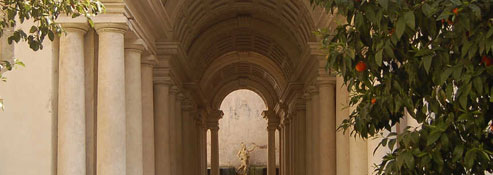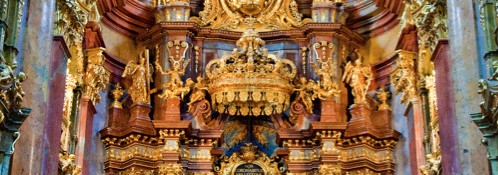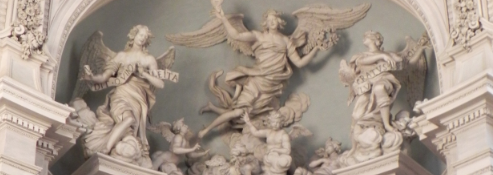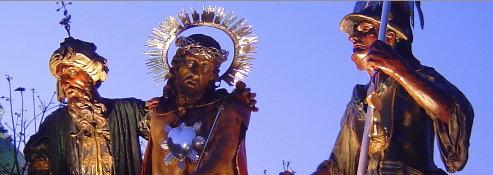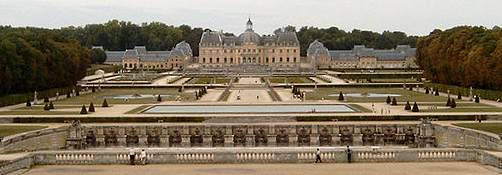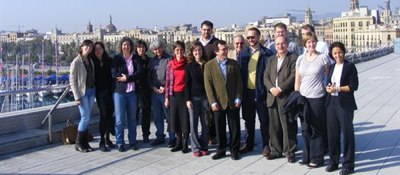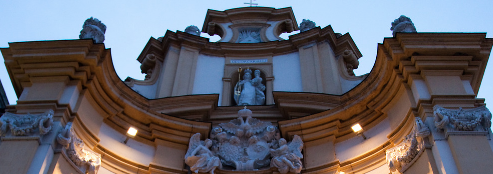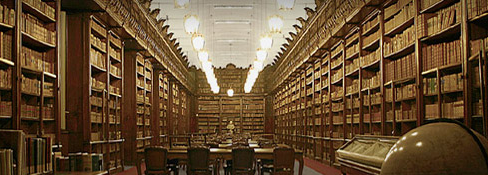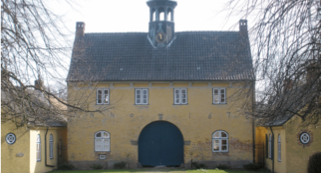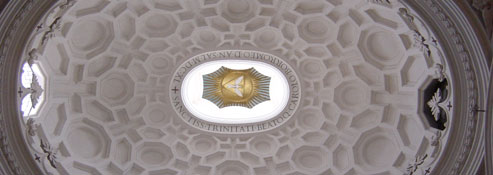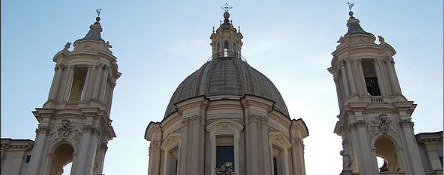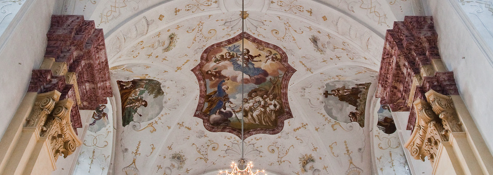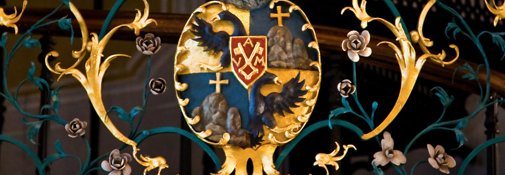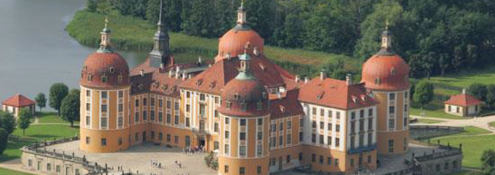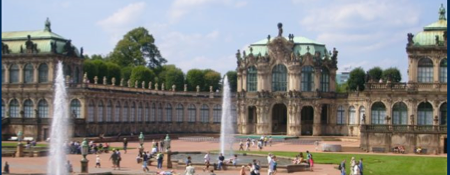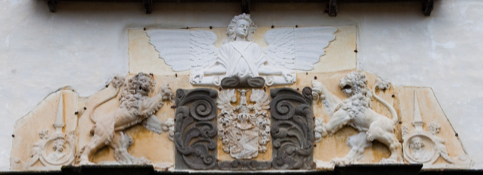Zwinger, Japanese Palace and Pillnitz Castle are only the most famous examples of buildings in Dresden, whose architectural planning and design were influenced by the baroque court architect Matthäus Daniel Pöppelmann (1662-1736). [2] To date, these buildings are an expression of baroque horizons and spatial fantasies. The aim of this paper is to show, that the court architects' work was closely linked to his private life. This can be reconstructed on the basis of his estate record which is preserved at the Dresden State Archive and consists of a long register of paintings, books, valuables and other precious objects. [3]
1. Pöppelmann's last will
Pöppelmann died on the night of January 17, 1736, at the age of 73 years. It was primarily in the interest of the heirs that all the property of the former court architect was recorded. Besides his three sons, Johann Adolph (1694-1773), Carl Friedrich (1698-1750) and Christian Wilhelm (1701-1782), Daniel Pöppelmann left the daughters Rachel Dorothea (1693-1761), Erdmuth Sophie (1695 -?) and Luise Catharina (1712-1775). The fourth daughter, Eleonore Dorothea, had died a few years before and had been married to the later Oberhofgerichtsrat Dr. Johann Hieronymus Stenger. She had given birth to two daughters, who had grown up in the care of the grandfather, Matthäus Daniel Pöppelmann, and were therefore taken into account when dividing the estate. So the court architect had already laid down in his testament that each of his heirs should receive one-seventh of his possessions. To verify this, it would be necessary to have a closer look at Pöppelmann's estate record.
2. The estate
2.1 Property
The research has repeatedly pointed out that Pöppelmann's career can be described as unusual because of his diverse building projects and activities. [4] His first employment at the Dresden court is dated to the year 1686. From 1695 to 1710 Pöppelmann dedicated himself to some civil construction projects and improved the family income through the purchase of land, which he developed with houses and resold profitably. [5] In 1712 Pöppelmann moved to an official residence, which was located in the so-called 'Frau Mutterhaus', nearby the Dresden castle. 1712 was also the year of death of his first wife Catharina Margarethe Stumpf, who died shortly after the birth of the youngest daughter. [6]
In February 1713 Pöppelmann married his second wife, Anna Christina Möller, a wealthy widow from Görlitz, and it seems that this second marriage had been a decisive event for his private life. But not just the marriage changed his life, also his own achievements become visible in the following years. On January 8, 1714, he was conferred the Dresden rights of citizenship [7] and a few months later, in May 1714, the Elector Augustus the Strong promised him an estate worth 5.000-6.000 talers, because of having prevented a dam accident two years before. [8] The estate, which was actually given to Pöppelmann a few years later, was situated in Seeligstadt near by Stolpen, and is also listed in the estate record. After Pöppelmann's death it was sold by the heirs for about 2.100 tales. [9]
However, more important than the estate at Seeligstadt, was the so-called 'Feldschlösschen' at Dresden-Plauen, an estate bought for 6.000 talers by Pöppelmann's second wife Anna Christina on June 12, 1714. [10] After the death of his wife in 1729 the property passed on to the court architect. The bill of sale is mentioned in his estate record as well as in a contemporaneous written Inventarium über des verstorbenen Ober-Land-Baumeisters Herrn Matthias Daniel Pöppelmanns Verlaßen-/schafft. [11] When Pöppelmann died, it was bequeathed together with all its furniture and inventory, to the second son Carl Friedrich, who had to pay 666 talers and 16 groschen to the other heirs in return for the Feldschlösschen. [12]
This sum seems actually very low considering the original purchase price of 6.000 talers and the facilities of the Feldschlösschen at the time of acquirement. Already in 1714, the estate was a stately home that consisted of a residential building, a pub house, a barn, stables and a pleasure and bath house. [13] Further, Matthäus Daniel Pöppelmann himself expanded the Feldschlösschen with other buildings and thus possibly increased again the value of the property. [14] Although he does not specify the interventions in his testament and there aren't any records, contemporary descriptions can provide a vague idea of the external appearance of the Feldschlösschen: "Besondern Ruf hatte schon damals das Feldschlößchen, wo man auf der Höhe nach Plauen zu im J. 1730 einen grün bedeckten Tanzsaal errichtete" [15], had written for example Gustav Klemm in a retrospective, referring to the Dresden historian Johann Christian Crell (1690-1762), called Icander.
Due to its facilities he considered the Feldschlösschen one of the 14 most popular public amusement places in Dresden. So he continues with a description of the estate: "Es waren hier mehrere Kegelschube. Vor dem Gebäude war ein Rondel von Rosen, worinnen Concerte gegeben wurden. An den Seiten waren hohe Baumreihen mit Tischen und Bänken. Zum Vergnügen seiner Gäste hielt der Wirth viele Jahr lang einen Bären". [16] This description of the Feldschlösschen as a remarkable ensemble of several buildings and gardens coincides very well with a map of the area from 1731, which shows the garden of the Feldschlösschen based on the baroque principle of symmetry and which is preserved in the Saxon State Archives in Dresden.
Estimated by the department of Dresden at 8.987 talers, the Feldschlösschen was sold a few years later for a total of 7.450 talers when Carl Friedrich died. [17] The reason for this significantly lower selling price was probably based on the condition of the property, which was described as run-down. [18] One possible reason for the bad state could have been the constant absence of Carl Friedrich Pöppelmann, who lived actually in Warsaw. Further, his absence and the dilapidation of the buildings could have been a trigger for quarrels among the heirs when the father gave the estate to the second son.
2.2 Paintings
Despite the written records of the distribution of Pöppelmann's possessions, the exact disposition of the objects cannot be completely determined. In some cases, the division of the objects seemed left to the heirs themselves. For example, the estate record contains a note, that all clothes, weapons and books should be divided among the three sons. [19] In other cases, the property was explicitly attributed to individual children, as in the case of the drawing instruments and architecture-related objects which passed on to the architect Carl Friedrich. However in general, it seems that Matthäus Daniel Pöppelmann bequeathed his property respecting his children's and grandchildren's personal and professional interests, and not regarding a balanced division. Therefore, it would only be a logical consequence that the paintings and other art objects were given to the court painter Johann Adolph Pöppelmann.
However, there is no further evidence for this hypothesis. In the estate record of the eldest son, there are no indications of former possessions of the Father. In 1773, Johann Adolph died in debt and it could be that he had previously sold his part of the inheritance. Also the inventory of his own house in Dresden-Friedrichstadt was scheduled for auction after his death in order to settle outstanding debts. [20] Due to the brief descriptions of the paintings in the estate record of Matthäus Daniel Pöppelmann, the works cannot be linked with the paintings in the estate record of Johann Adolph. Also information regarding the artists and the date of origin are not mentioned, which make it difficult to identify any specific paintings. Nevertheless, we can record some general facts.
The major part of the collection was housed in a room facing the Schloßgasse and can be described as mostly decorative assembly of still lifes, portraits, landscapes and historic paintings, which were varied in their individual elements - graphics and oil paintings, with or without framing, on paper or canvas. Also an engraving of the Zwinger and its garden was found in this room, but it must have seemed lost among the numerous portraits, fruit and flower pieces, even if the gold framing assumes a special appreciation on the part of the owner. [21]
It is remarkable that none of the works has a value of more than four talers, which confirms the assumption, that they were initially acquired for private use. In addition, the short descriptions of the paintings in the estate record as for example "Ein viereckicht Bild auf Leinwand gemahlt in gelben Rähmen eine alte Frau vorstellend, welche Ducaten wiegt" [22] or "Ein Frauenzimmer so auf einem Instrument spielet in einem vergoldten Rahmen" [23], suggest a relationship to the Dutch Golden Age painting of the 17th century. Thus, the motif of a woman weighing gold or jewellery can be found in the Œuvre of the artists Jan Vermeer, Pieter de Hoogh and Frans Hals. Further, the so-called 'Goldwägerin' (Woman holding a Balance) is the subject of a same-named work by Rembrandt (1643), which is also listed in a Directory of paintings in the Electoral gallery of Dresden from 1771. [24] Although it can be denied that there was a painting by Rembrandt, Jan Vermeer, Pieter de Hoogh or Frans Hals in Pöppelmann's possession - especially since his painting was prized only 1 taler and 12 groschen. [25] It is at least possible that the court architect had a homonymous copy or a similar work painted by an unknown artist, especially when we think of the so-called 'Rembrandtism', [26] a widespread phenomenon of style in the course of the 17th and the 18th century.
Thanks to the grand purchases of August the Strong at the beginning of the 18th century, the works by Dutch masters were, in addition to those of the Italian High Renaissance, an integral part of the art collection at the Dresden court. [27] Sometimes, the Elector entrusted his court officials with art purchases abroad. [28] In 1710, Pöppelmann travelled to Vienna and Rome, where he received drawings from the Pope Clement XI in order to deliver them to the Elector of Saxony. [29] Regarding painting, such a service is not known in the case of Pöppelmann, but it can be assumed that he was familiar with fine arts through his travels. Further, his personal collection was certainly affected by his vocational contacts and his employment at the Dresden court.
2.3 Furniture
More representative than his paintings might have been the furniture of Pöppelmann's apartment. In a side room there was a red canapé with floral print as well as four similar chairs and two stools. Further, the room was furnished with twelve padded chairs made of green satin, [30] which might have accommodated a large number of people. This extensive assemblage of furniture suggests that the room was a kind of reception room for guests. According to the estate record, the facilities of the living room, which also contains a canapé and several chairs, must have been quite similar: small tables, some with marble tops and gilt feet in the form of angels, a writing desk made of walnut and a glass cabinet to store some drinking vessels with devotional dictums. [31] This ensemble conveys the idea of a comfortable room, which served for daily life. Even a fireplace room, enriched with smaller plasters and bronze works, was one of the rooms of Pöppelmann's apartment. This quite upscale lifestyle continues in the bedroom, whose centre must have been the wooden four-poster bed for two people with green and red fabric curtains. It was estimated at 20 talers, just as much as Pöppelmann's travel coach. [32]
2.4 Clothing
Not only was Pöppelmann ambitious at home, also outwardly he made an elegant appearance. This is primarily evidenced by the numerous pieces of clothing that belonged to the court architect, [33] including various fur-lined vests worth several talers, a hat adorned with golden Point d'Espagne as well as a coat with golden laces and sequins. However, most jackets, skirts and dresses were red-coloured. Pöppelmann followed the fashionable taste of his time, which was mainly oriented, as well as in the field of art and architecture, to France. So the architect of the Dresden Zwinger was also owner of two typical French allonge wigs.
2.5 Valuables and porcelain
Probably the most valuable items in Pöppelmann's household are listed in the fourth chapter of the Inventarium, which includes kitchenware and other household items. Remarkable are especially the detailed descriptions and the assessments of the individual items, including, for example, a golden feather pencil in a scabbard made of chagrin [34] or a golden tobacco tin, which was actually a present from the king and which was estimated at about 95 talers. [35] Further, the estate record mentions several chandeliers, bowls and other objects like a set of two gilded salad bowls, worth 32 talers, [36] a watering can with a bowl worth over 30 talers [37] and a Plat de ménage with bowls, a mustard pot and a sugar dish, estimated to be worth over 153 talers. [38]
The original provenance of these objects cannot be resolved and the question arises whether any of the listed items were originally part of the estate of Anna Christina Möller. At least one entry of the said section attests her continued presence. So not only Pöppelmann's wedding ring is listed here, but also another golden one with the inscription "M.D.P 28 February 1713". [39] It was kept in a small box of straw and undoubtedly belonged to Anna Christina Möller.
In any case, Pöppelmann's possessions indicate that he had earned a certain standard of living throughout his life and was able to maintain it until his death. In addition to porcelain and precious valuables he owned a large, inwardly gilded coffeepot worth 31 talers and a chocolate pot with associated cups, estimated to 99 talers. [40] Both coffee and chocolate were among the most important overseas goods and were believed to have a wide variety of effects on consumers. [41] The major part of the speculations on the medical effects is based on the numerous travelogues of the time. Adam Olearius, for example, whose volume Persianischer Rosenthal was also part of Pöppelmann's library, claimed in a report on his trip to the Russian Empire and Persia that an increased coffee consumption would lead to infertility. [42]
Also important was the preparation of the coffee. If necessary, one could refine it with sugar, honey, cinnamon or cardamom [43] - spices and additives, whose positive effects are also discussed in Pietro Andrea Mattioli's so-called Kräuterbuch (herbal book), which was also registered as part of Pöppelmann's private library. [44] Due to his little book of household accounts, which is mentioned in the estate record, we can certainly say that Pöppelmann in 1734/35 had bought several pounds of coffee beans and honey, cinnamon and cardamom from a merchant named Johann Ludwig Seeber. [45] The corresponding bill is also cited in Pöppelmann's estate record. According to that, also nuts, almonds, ginger, sugar, pickles, Dutch cheese and Turkish raisins had been on the court architects shopping list, as well as rice, tea and pepper. Further, the bill reveals the consumption of fish and molluscs, including river lampreys, anchovies and mussels. That he was in good company with this culinary selection, is also confirmed by the recent archaeological excavations in the living area of Pöppelmann, the Quarter VIII at the Dresden Neumarkt. The excavations unearthed glasses and porcelain, as well as oyster shells, which are notable clues of the festivities celebrated by the noble inhabitants. [46]
2.6 Books
In contrast to porcelain, clothing and other legacies from Pöppelmann's possession, the books included in his private library constitute a much more precisely defined item. Even though they were recorded rather carelessly and deficient after their owner's death, it is still possible in some cases to reconstruct their authors, complete titles and the respective year of publication. [47] In the architect's estate record are listed 85 titles [48] - often consisting of more than one volume. The notary in charge estimated their value to 107 talers and 19 groschen, [49] which about equals the value given for the precious chocolate pot mentioned above. Nevertheless, a closer look at the contents of the books reveals an important clue to the sphere of knowledge and production in Pöppelmann's life.
In spite of the perhaps 1.000 new books that went on sale at the German book fairs every year in the late 17th century [50] - some 250 years after the invention of printing - only a few members of the slowly developing urban middle class owned comprehensive libraries. Usually the size of the flat and the monthly wages determined the dimension of the individual possession of books. In Dresden, it was at least comparably easy to purchase recent books and periodicals, given that a lot of book sellers - often printers and publishers at the same time - had been settling in the capital of the Saxon Electorate where they could benefit not only from the presence of the court, but also from the proximity of the Leipzig book fair.
In order to appreciate the specific composition of Pöppelmann's book collection, it is necessary to compare it with other contemporary private libraries in the context of the Dresden court. Therefore, the book inventories in the estate records of the architect Zacharias Longuelune (1669-1748), the jeweller Georg Friedrich Dinglinger (1668-ca. 1746), and the polymath and co-inventor of the Meissen porcelain, Ehrenfried Walther von Tschirnhaus (1651-1708) were analysed. Sometimes, the inventories, which were made after the death of the owner, offer detailed information on the value of a library and its destiny. The accuracy of such an inventory particularly depended on the commissioned notary.
The main topics that can be found as thematically similar works in each library can be specified as follows: on the one hand there are historiographical works as well as works on geography, state system and economy, which represent the basic contents of a contemporary library. On the other hand the libraries of Pöppelmann, Longuelune, Dinglinger and Tschirnhaus contained standard works about architecture, arts and crafts. These topics are specifically extended by works on mathematics, fortifications and military affairs. Dictionaries and grammars were needed for the lecture of foreign language books - including the Bible - and for the acquisition of language, for example Des Pepliers' textbook of the French language in Pöppelmann's possession. Furthermore, almost all of the above-named libraries contained some works of ancient authors, mostly relevant titles by Caesar, Cicero, Seneca, and Ovid. To varying degrees the book collections contained works that are classified as belles-lettres. This comprises dramas, fables and poetry collections. Sometimes, there are also represented sections on education, botany and medicine. Not least, devotional literature and theological-philosophical treatises - some with critical content or explicit polemics against Papacy and Judaism - are essential components of the individual libraries. Each thematic evaluation is related to the professional needs of the owner, but can also provide information about his personal interests.
The priorities and the scope of the book collections are directly related to the social position of the owner. Initially the establishment and maintenance of a private library was more common in aristocratic circles than in the urban bourgeoisie, which was only constituted in the 18th century. The persistence of local manorial estates, which often remained for many generations in the same family, offered the possibility to create, maintain and expand a large collection. The library of Ehrenfried Walther von Tschirnhaus is a particularly extensive and well-sorted example of such a collection, which covers a wide spectrum of topics. Tschirnhaus had studied in Leiden in the Netherlands and travelled several times to other European countries for study purposes. He had met some well-known European scientists in person, such as Baruch de Spinoza (1632-1677), Christiaan Huygens (1629-1695) and Gottfried Wilhelm Leibniz (1646-1716).
Tschirnhaus' library contained contemporary issues of scientific basic manuals, of theological works and fine literature in their original language as well as numerous grammars and dictionaries. One must assume that Tschirnhaus had far-reaching language skills and was not dependent on translations of the original editions. Due to the diversity of interdisciplinary works contained in the library - also including popular fiction, such as 'gallant' novels, which corresponded to the prevailing taste - this collection can be regarded as an example for the private library of a polymath in the tradition of the 17th century. After Tschirnhaus' death, his private library was scattered and destroyed as a consequence of looting, bureaucratic failure, years of incorrect storage in a damp cellar at Görlitz and finally by the auction sale of the remaining books.
Matthäus Daniel Pöppelmann, of whose educational and professional education is nothing known until his arrival in Dresden in 1680, purchased most of his books pragmatically. So the works on architecture, which means tracts on the ancient order of columns, basic works on perspective and fortress construction or copper engraving volumes with illustrations of important buildings by famous colleagues, make about one third of the library supply handed down through the estate record. The inventory of Pöppelmann's library does not allow any conclusion on personal preferences or interests, apart from a considerable quantity of religious literature.
From the point of view of scale, Pöppelmann's book collection is rather modest. His Parisian counterpart Zacharias Longuelune owned at least thirty titles more, including belles-lettres as volumes of poetry, opera librettos and comedies, preferably in French. Apart from the thematic reception of antiquity by the Renaissance architects Pöppelmann's library doesn't contain titles of antiquity, while Longuelune had purchased at least Ovid's Metamorphoses, the Satyricon of Titus Petronius as well as works by Cornelius Tacitus - each in a French translation. Thus, Pöppelmann seems to have equipped his library rather by considerations of professional usability: the majority of the books found in his apartment after his death had a connection in terms of content to his official function at the Dresden court. This even applies to the only dramatic work in his possession: the light opera Camillus der Groß-Müthige or rather Camillo Generoso was created by the Italian composer Luigi Carlo Pietragrua (1665-after 1722) as a commissioned work on the occasion of Carnival in 1693 for a performance at the Dresden Court Theatre. The illustrations of the stage in this volume focus on the architectural design of scenes which remind of the theatre architecture following the example set by Sebastiano Serlio. As Pöppelmann was already working for the building control department in 1693, it is quite possible that he was involved in the design or in the execution of the stage. This hypothesis is also strengthened by the formal analogy between some printed stage images [Fig. 1] and illustrations from Pöppelmann copper engraving work of the Zwinger, published in 1729. [Fig. 2] [51]
Strangely enough, in Pöppelmann library are missing writings of renowned mathematicians in contrast to the libraries of Longuelune, Dinglinger and especially Tschirnhaus, including the works of Adam Ries (around 1493-1559; Tschirnhaus), Simon Stevin (around 1549-1620; Tschirnhaus), Adriaan Vlacq (1600-1667; Tschirnhaus), Athanasius Kircher (1602-1690; Dinglinger, Tschirnhaus) or Jacques Ozanam (1640-1718; Longuelune, Tschirnhaus). This is surprising, especially because of Pöppelmann's engineering activities in the entire Electorate of Saxony until 1705, which comprised the responsibility for surveying as well as the construction of roads and bridges. But Pöppelmann's knowledge was rather based on the Theatrum Machinarum novum by Georg Andreas Böckler (around 1617 to 1687); especially when it came to design the spectacular plans of the Zwinger garden. The work by Georg Andreas Böckler combines technical findings and inventions with curiosities. [52] Accordingly, the target group was not the intellectual professional elite, but a broader, more technically interested audience. [Fig. 3] Also the Cimelium Geographicum Tripartitum (in German subtitle Dreyfaches Geographisches Kleinod) by Tobias Beutel contains tables with dimensions of the Saxon territory and instructions for cartography, but overall it is pervaded by moral recommendations and descriptions of distant lands and treasures. [Fig. 4] In order to cope with his versatile practical tasks as master builder Pöppelmann had to fall back on books at the Electoral library that were available to him as court official. Besides, we know that Pöppelmann borrowed three books from his colleague Johann Christoph Knöffel, which is mentioned and marked with a note in the estate inventory.
A quantitative main emphasis of Pöppelmann's library lies on historiographical works. These can be divided into city chronicles, biographies, country-specific descriptions of important historical events, compendia with more geographical focus and universal-historical writings. Until the 18th century historiographical works of the modern times were usually composed of elements of various disciplines. The intention of their authors focused not on the report of historical events as a series of objective facts; it was rather important for the historians to throw light on the events from different points of view - mostly according to Christian standards - and to assess them. Therefore the suitability as a moral example was seen as a central function of a historical event. [53]
For example the universal history by the astrologer and mathematician Johannes Carion (1499-1537), was extensively revised by Philipp Melanchthon (1497-1560) and Caspar Peucer (1525-1602) and published for the first time in 1573 in Wittenberg under the title Chronicon Carionis. It takes up the Lutheran idea of the simultaneous existence of two 'regiments', namely a divine and a secular one. So the political and the ecclesiastical history concerning events are conveyed separately. However, the authors interpret both positions as equally decisive factors for the history. [54] With the Chronicon Carionis Pöppelmann owned a kind of basic work, [55] which many later historians referred to thanks to its systematic structure. Nevertheless, in the German language area a historiography, which got along without biblical calendar and the prospect of a prophesied end of the world, was only established in the 19th century. [56]
Another differing concept of knowledge transfer was pursued by some of the scholarly journals that were published especially since the beginning of the 17th century, such as the series Theatrum Europaeum, which was published between 1634 and 1734 in Frankfurt on the Main. [57] The nine volumes of the Theatrum Europaeum contained in Pöppelmann's estate inventory are estimated at 24 talers. Therefore the Theatrum Europeum is the most valuable book title recorded in the estate record - and not without reason. Every single volume is a generous tome with more than 1.000 pages and many high quality illustrations made by the Merian workshop in Frankfurt.
Unlike the chronicles, whose arguments based on the biblical story of the Old Testament, the Theatrum Europaeum mixed astrological phenomena, contemporary maps, townscapes, political documents and military formations with reports of scandalous events, spectacular "Wunder- und Mißgeburten" [58] (wondrously and seriously deformed foetuses) and technical inventions. The highly detailed engravings in large-format should help to support the suggested reality content. Due to this intermedial manner the historical contexts can be comprehend sensuously by the reader. Particularly striking is the knowledgeable integration of spatial impressions of architecture into the representation of individual events, executed by the engravers involved in such a project of the century.
The realistic urban backgrounds and the landscapes obtain the function of theatre stages where historically relevant events, such as elegant orchestrations and trials with public appeal, but also natural disasters take place. [Fig. 5] [59] That such periodicals were very popular in the early 18th century can also be shown by the library inventories of Dinglinger and Tschirnhaus. The former restricted himself to the subscription of the magazine Gespräche aus dem Reiche der Todten by David Fassmann, who used the dialogue form to communicate historical and political relevant contents. [60] Tschirnhaus in comparison obtained the magazine series Acta Eruditorum (Leipzig) and Journal des Sçavans (Paris) that were explicitly addressed to scholars and further, the more popular science periodicals Mercure historique et politique and Curieuse Bibliothec as well as the Mercure galant that is primarily dedicated to the entertainment of the reader.
As versatile as the Theatrum Europaeum were the compilations by the so-called 'Buntschriftsteller'. [61] They also combined an interdisciplinary hotchpotch of interesting topics before systematically built up encyclopaedias caught up in the middle of the 18th century. In that connection the prospect of exotic worlds outside of Europe played a crucial role.
Richly illustrated works such as the Ost- und West-Sinesische Lust- und Staats-Garten by Erasmus Francisci (1627-1694) not only served to communicate knowledge, but above all, to amuse the reader. Francisci, who had never undertaken a big journey except an educational trip through Europe, based his work on reports of commercial travellers or diplomatic embassies to Asia and overseas. [Fig. 6]
Besides the prolific writer Francisci also Eberhard Werner Happel (1647-1690) was one of the most popular authors of compilations in his time, by whom Pöppelmann owned a multi-volume historiographical work. Even Johann Michael von Loen (1694-1776) adapted such compilations as visible in the chapter headings [62] of his deontology Sylvanders von Edel-Leben Zufällige Betrachtungen Von Der Glückseeligkeit der Tugend […], which also contains a laudatory description of the Dresden Zwinger (in the first chapter Discours Sur L'Architecture, Composé au sujet de l'Orangerie Royale quiest à Dresde). Last but not least the popularity of all these books is based on their illustrations that turned out to be an additional medium for knowledge transfer and received striking significance due to their high artistic quality.
Such sources were also used by Hans Jacob Christoffel von Grimmelshausen (around 1622-1676) for writing his novel Der abentheuerliche Simplicissimus Teutsch. The terse entry "Simplicissimus, defect" in Pöppelmann's estate record will not quite fit in with the adventurous contents of the book. For Pöppelmann this virtuoso description of the circumstances during the Thirty Years' War may have been of peculiar interest. His hometown Herford was badly damaged through a fire during the war, and a few years later, it lost its economic and cultural significance as well as its independence due to the Peace of Westphalia and the takeover by the Electorate Brandenburg-Prussia.
However, the most personal part of Pöppelmann's library is represented by the books with spiritual content, including an edition of the Luther Bible with a preface of Gottfried Hoffmann (1658-1712, No. 80), several devotional books and collections of sermons and treatises on the Christian life-style. Pöppelmann's hometown Herford had already professed the Lutheran faith in 1530 as one of the first North German cities. The two city churches had been converted and the interiors were redesigned according to Lutheran gusto. In 1602 Pöppelmann's great-grandfather, a former Mayor of Herford, had donated a new pulpit for the Herford St. John's-Church. [63] This suggests an early Lutheran family tradition, which influenced Matthäus Daniel Pöppelmann in its infancy and is still reflected in his collection of books. Therefore it is quite conceivable that the religious conditions in the Electorate of Saxony played a crucial role for Pöppelmann choosing his new home town - even if it could have been purely economic reasons which disposed him as a young man to leave Herford.
One work in Pöppelmann's possession, that postulated reforms in the Lutheran liturgy, [64] is the book Wahres Christentum by the clergyman Johann Arndt (1555-1621) from Anhalt. Posthumously, the initially four-volume work was supplemented by two further volumes with short essays and letters from Arndt. [Fig. 7] The author also integrated texts of pre-Reformation mystics in his work, which were interpreted in the Lutheran sense. Therefore he was reputed by his critics to be a heretic and fanatic. [65] He turned against a purely academic understanding of theology and supported an individually lived devotion. [66] This critical content of the work, however, does not provide evidence of Pöppelmann's personal point of view; especially because the book is one of the most widely read devotional works of German Protestantism. [67] The number of devotional books in his library suggests rather to the fact that he was striving after the example of his Westphalian ancestors, to live as 'true Christian' and good Lutherans and in Pöppelmann's library can be found further instructions for such a way of life, as for example a collection of sermons by the theologian August Hermann Francke, who was an advocate of the earthly life facing Christianity. According to Francke, this should be manifested especially in charitable acting, and he himself set a good example by establishing foundations in Glaucha near Halle. [68]The comparison with the book collection of Tschirnhaus make obvious that the opening of the theologically interested Lutheran readers towards mystical and spiritualistic literature as well as the study of controversial theological opinions (at least within an international network of intellectuals) was not unusual. Tschirnhaus' inventory includes a series of works whose doctrines were not at all corresponding with the long-established Lutheran doctrine of the early 18th century. Beside the works of the late medieval spiritualist Johannes Tauler (c. 1300-1361) and the theosophists Jacob Boehme (1575-1624) from Görlitz, Tschirnhaus' library contains also the writings from Philipp Jacob Spener, who worked as a court preacher in Dresden until 1691 and aimed, as well as Johann Arndt, for an earthly Life facing church reform. Further, it should be emphasized that even Tschirnhaus had orthodox basic works on the Lutheran doctrine such as several contemporary translations of the Bible in different languages or Leonhard Hutters Compendium locorum theologicorum ex scripturis sacris et libro concordiae as well as writings of Luther himself.
Also for the goldsmith Dinglinger religious works played a crucial role, even though he seemed not to be interested in current reform efforts and other disputes within the church. His Upper Swabian birthplace Biberach had joined the Reformation in 1531. When Dinglinger died, his library consisted of a quarter of Protestant devotional literature. Zacharias Longuelune lived as a Catholic in the Saxon diaspora, before he moved to Warsaw, and read exegetical texts in his native language.
3. Conclusion
In comparison with the mentioned contemporary libraries it can be stated that Pöppelmann's book collection had primarily the function of a working library and differs, regarding its content, from comparable collections. His books were meant for daily use and less for representation.
This can be inferred from the sporadic information on the materials of the book covers (mostly parchment, but also Cordovan leather) that were suitable for everyday use. Nevertheless Pöppelmann's private library can be seen as a model for a special social class - between the nobility and the urban middle class - in the context of the Saxon court. [69] This is primarily proven by its composition consisting of a solid basic stock of specialized literature, a high number of devotional literature as well as popular scientific compilations and magazine series. A pharmacopoeia with detailed illustrations of plants and recipes for their use is neither missing in Pöppelmann's library nor in Dinglinger's and Tschirnhaus'.
To summarize and according to Pöppelmann's estate, the court architect cannot be proven a bibliophile, who attached value to a completely established library or regarded books as a financial investment. The inventory of his apartment in the Dresden Schloßgasse rather represents the image of a man who in the course of his life had managed, thanks to his artistic talent, to be promoted from an unpaid staff of the Building control department to a confidant of Augustus the Strong, and whose lifestyle had gradually acquired courtly habits. When Pöppelmann died he was in possession of innumerable courtly-oriented 'status symbols' such as valuable dishes, jewellery, inlaid tables and clothing made of high quality fabrics. The bill received from the merchant Seeber, who traded with exotic goods such as spices, olives, anchovies, tea, coffee and cocoa, shows that even the everyday consumer behaviour of Pöppelmann differed from the habits of the urban bourgeoisie.
The discrepancy between Pöppelmann's belonging to the court and his origin from a middle class family reveals itself especially in the objects that are not present in his estate record as for example musical instruments, valuable paintings by famous artists, dictionaries and grammars of Latin, Greek or Hebrew. All these things would allow a conclusion to be drawn about a comprehensive education or long-term established, befitting habits. All this makes it more impressive that Pöppelmann, with all his empathy and professional expertise and especially since his promotion to master builder of the Dresden court, was able to meet the megalomaniac plans of Augustus the Strong by converting parts of them into reality.
Bibliography:
ARNDT, JOHANNES, Herrschaftskontrolle durch Öffentlichkeit: Die publizistische Darstellung politischer Konflikte im Heiligen Römischen Reich 1648-1750, Göttingen 2013.
BÄCHLER, HAGEN, Die Bücher aus dem Nachlaß Matthäus Daniel Pöppelmanns. Ein Beitrag zu seinem Weltbild in KURT MILDE (ed.), Matthäus Daniel Pöppelmann 1662-1736 und die Architektur der Zeit Augusts des Starken, Dresden 1990, pp. 40-50.
BARTSCH, MAIKE/KOCH, NINA Warum stiften die Stifter? Schenkungen in der Johannis-Kirche und der Jakobi-Kirche in GREGOR ROHMANN (ed.), Bilderstreit und Bürgerstolz. Herforder Kirchen im Zeitalten der Glaubenskämpfe, Bielefeld 2006, p. 27-37.
DIECKMANN, FRIEDRICH, Pöppelmann oder Die Gehäuse der Lust, Dresden 2012.
DÖRING, BRUNDO ALFRED/ERMISCH, HUBERT GEORG (eds.), Matthes Daniel Pöppelmann. Der Meister des Dresdener Zwingers, Dresden 1930.
GALL, FABIAN/HEMKER, CHRISTIANE/SCHÖNE, SUSANNE, Zwischen Schloss und Neumarkt - Archäologie eines Stadtquartiers in Dresden, Dresden 2008.
GEMEINHARDT, PETER, Das Chronicon Carionis und seine Überarbeitung durch Philipp Melanchthon in MARTIN WALLRAFF (ed.), Welt-Zeit: christliche Weltchronistik aus zwei Jahrtausenden in Beständen der Thüringer Universitäts- und Landesbibliothek Jena, Berlin 2005, pp. 115-125.
HECKMANN, HERMANN, M.D. Pöppelmann als Zeichner, Dresden 1954.
HECKMANN, HERMANN, Matthäus Daniel Pöppelmann. Leben und Werk, München/Berlin 1972,
HERTZIG, STEFAN, Das Dresdner Bürgerhaus in der Zeit Augusts des Starken. Zu Entstehung und Wesen des Dresdner Barock, Dresden 2001.
HOCHMUTH, CHRISTIAN, Das Ordnen des Neuen. Zur lokalen Aneignung überseeischer Waren in deutschsprachigen Diskursen und Dresdner Praktiken vom späten 17. bis zum frühen 19. Jahrhundert, Dresden 2007.
KLEMM, GUSTAV, Die Wirthshäuser und öffentlichen Belustigungsorte Dresdens im Jahre 1770 in PAUL GOTTLOB HILSCHER (ed.), Der Sammler für Geschichte und Alterthum, Kunst und Natur im Elbthale, Vol. 2, Dresden 1837, pp. 375-377.
KUHN, THOMAS K., Religion und neuzeitliche Gesellschaft, Tübingen 2003.
MARX, HARALD (ed.), Matthäus Daniel Pöppelmann, der Architekt des Dresdner Zwingers, Leipzig 1989.
MATTIOLI, PIETRO ANDREA, Kreutterbuch deß hochgelehrten unnd weltberühmten herrn D. Petri. Andreae Matthioli […], Frankfurt am Main 1590.
MERTENS, KLAUS, Das kursächsische Oberbauamt und Matthäus Daniel Pöppelmann, in KURT MILDE (ed.), Matthäus Daniel Pöppelmann 1662-1736 und die Architektur der Zeit Augusts des Starken, Dresden 1990, pp. 28-38.
MILDE, KURT (ed.), Matthäus Daniel Pöppelmann 1662-1736 und die Architektur der Zeit Augusts des Starken, Dresden 1990.
N.N., Allerley Nützliches und Curioses über den Kaffee aus alter und neuer Zeit, Berlin 1927.
POHLIG, MATTHIAS, Zwischen Gelehrsamkeit und konfessioneller Identitätsstiftung. Lutherische Kirchen- und Universalgeschichtsschreibung 1546-1617, Tübingen 2007.
RIEDEL, JOHANN ANTON/WENZEL, CHRISTIAN FRIEDRICH, Verzeichniß der Gemälde in der Churfürstl. Gallerie in Dresden, Leipzig 1881.
ROSSBACH, NIKOLA, "Zu besserer Begreiffung aller Materien". Wissensorganisation und -vermittlung bei Georg Andreas Böckler, Architect & Ingenieur in FLEMMING SCHOCK (ed.), Polyhistorismus und Buntschriftstellerei. Populäre Wissensformen und Wissenskultur in der Frühen Neuzeit, Berlin/Boston 2012, pp. 149-167.
SächsHStA Dresden, 10026 Geheimes Kabinett, Loc. 749/1, Teil 2, fol. 451-453, Lettres du Secretaire Puchet, au Cte de Lagnasc concernant les intérets du Roi et de la Religion Catholique à la Cour de Rome.
SächsHStA Dresden, 10047 Amt Dresden, Nr. 3055, Acta Judicialia Die Ob-und Consignat-tion des Verstorbenen Hofmahler H. Johann Adolph PöpelmannsNachlaß samt was dem anhängig betr. Ergangen vor dem Amt Dreßden Anno 1773.
SächsHStA Dresden, 10047 Amt Dresden, Nr. 3056, Acta Commissionis/Des verstorbenen Königl. Ober-/Landbaumeister Herr Mattheus/Daniel Pöppelmanns Nachlaßes/Ob. und Designation auch Inven[tar]/sambt was deme mehr anhäng[ig]/betr.
SächsHStA Dresden, 10047 Amt Dresden, Nr. 3057, Die Theilung des Verstorbe/nen Herren OberLandBaumeister/ Pöppelmanns gesamten Nach/laßes unter deßen Kinder und/ Enckel, benebtens den Anhängen/Betr. […].
SächsHStA Dresden, 10047 Amt Dresden, Nr. 3058, Inventarium über des verstorbenen Ober-Land-Baumeisters Herrn Matthias Daniel Pöppelmanns Verlaßen-/schafft/gefertigt/ beym/ Amte Dreßden/ao: 1736.
SächsHStA Dresden, 10069 Amt Stolpen, Nr. 282, Verkauf des von dem Oberlandbaumeister Matthäus Daniel Pöppelmann hinterlassenen Richtergutes in Seeligstadt durch die Erben […].
SächsHStA Dresden, 10069 Amt Stolpen, Nr. 483, Schätzung des durch den Tod von Johann Boden apert gewordenen Lehngerichts in Seeligstadt und Belehnung des Landbaumeisters Matthäus Daniel Pöppelmann.
SächsHStA Dresden, 10684 Stadtgericht Dresden, Nr. 1750, Herrn Carl Friedrich von Pöpelmannsweyl. Ihro König. Majt. in Pohlen und kurfürstl. Durchl. zu SachßenHoofbestalt gewesenen general Majors, hinterlaßenes und vorm Wilßdorfer Tore am plauischen gelegenes Vorwerg das Schlößgen genannd, ingleichen deßen Verkaufung betr.
SCHOCK, FLEMMING (ed.), Polyhistorismus und Buntschriftstellerei. Populäre Wissensformen und Wissenskultur in der Frühen Neuzeit, Berlin/Boston 2012.
SCHRAMM, HELMAR, Kunstkammer - Laboratorium - Bühne im 'TheatrumEuropaeum'. Zum Wandel des performativen Raums im 17. Jahrhundert in HELMAR SCHRAMM/LUDGER SCHWARTE/JAN LAZARDIG (eds.), Kunstkammer - Laboratorium - Bühne. Schauplätze des Wissens im 17. Jahrhunderts, Berlin/New York 2003, p. 11-34.
SPENLÉ, VIRGINIE, Der Monarch, seine Agenten und Experten. Institutionelle Mechanismen des Kunstankaufes unter August II. und August III. in BARBARA MARX (ed.), Kunst und Repräsentation am Dresdner Hof, München/Berlin 2005, pp. 228-260.
STAATLICHE KUNSTSAMMLUNGEN DRESDEN (eds.), Matthäus Daniel Pöppelmann. 1662-1736. Ein Architekt des Barocks in Dresden (anlässlich des 325. Geburtstages), Dresden 1987.
THIMANN, MICHAEL, "Ein lieblicher Betrug der Augen". Die deutsche Malerei zwischen 1600 und 1750 in FRANK BÜTTNER (ed.), Barock und Rokoko. Geschichte der bildenden Kunst in Deutschland 5, München 2008, pp. 514-523.
TILLER, ELISABETH/LIEBER, MARIA (eds.), Pöppelmann 3D. Bücher - Pläne - Raumwelten, Dresden 2013 [URL: http://nbn-resolving.de/urn:nbn:de:bsz:14-qucosa-118312 ].
WALLMANN, JOHANNES, Mystik und Kirchenkritik in der lutherischen Kirche des 17. Jh. - Johann Arndt, Joachim Lütkemann, Philipp Jakob Spener in MARIANO DELGADO/GOTTHARD FUCHS (ed.), Die Kirchenkritik der Mystiker. Prophetie aus Gotteserfahrung. Vol. II: Frühe Neuzeit, Fribourg 2005, pp. 343-366.
WELS, VOLKHARD, Unmittelbare göttliche Offenbarung als Gegenstand der Auseinandersetzung in der protestantischen Theologie der Frühen Neuzeit in HERBERT JAUMANN (ed.), Diskurse der Gelehrtenkultur in der Frühen Neuzeit: Ein Handbuch, Berlin/New York 2011, p. 747-808.
WITTMANN, REINHARD, Geschichte des deutschen Buchhandels, München 1991.
Images
1. MARTIN KLETZE, Ein Garten auff des Camill Land=Gut, Panel 7 in CARLO LUIGI PIETRAGRUA, Camillus Der Groß-Müthige DRAMA Vorzustellen auf dem Teatro Des Durchleuchtigsten Chur-Fürstens zu Sachßen, Dresden 1693.
SLUB Dresden, Signature: MT.4.111.

2. Anonymous engraver, based on a design by Matthäus Daniel Pöppelmann, Vue du bain derriere le Salon a main droite in M.D. PÖPPELMANN, Vorstellung und Beschreibung Des […] so genannten Zwinger=Gartens Gebäuden, Oder Der Königl. Orangerie zu Dreßden, Dresden 1729.
SLUB Dresden/Map collection, Signature: B1985.
![2. Anonymous engraver, based on a design by Matthäus Daniel Pöppelmann, Vue du bain derriere le Salon a main droite in M.D. PÖPPELMANN, Vorstellung und Beschreibung Des […] so genannten Zwinger=Gartens Gebäuden, Oder Der Königl. Orangerie zu Dreßden, Dresden 1729. 2. Anonymous engraver, based on a design by Matthäus Daniel Pöppelmann, Vue du bain derriere le Salon a main droite in M.D. PÖPPELMANN, Vorstellung und Beschreibung Des […] so genannten Zwinger=Gartens Gebäuden, Oder Der Königl. Orangerie zu Dreßden, Dresden 1729.](/sites/default/files/fig2.jpg)
3. Panel 109 in GEORG ANDREAS BÖCKLER, Theatrum Machinarum Novum, exhibens aquarias, alatas, iumentarias, manuarias; pedibus, ac ponderibus versatiles, plures, et diversas molas. […] Cum Utilibus, & rarioribus Hydrotechnematis […], Nürnberg 1662.
SLUB Dresden, Signature: Mechan.36.
![3. Panel 109 in GEORG ANDREAS BÖCKLER, Theatrum Machinarum Novum, exhibens aquarias, alatas, iumentarias, manuarias; pedibus, ac ponderibus versatiles, plures, et diversas molas. […] Cum Utilibus, & rarioribus Hydrotechnematis […], Nürnberg 1662. 3. Panel 109 in GEORG ANDREAS BÖCKLER, Theatrum Machinarum Novum, exhibens aquarias, alatas, iumentarias, manuarias; pedibus, ac ponderibus versatiles, plures, et diversas molas. […] Cum Utilibus, & rarioribus Hydrotechnematis […], Nürnberg 1662.](/sites/default/files/fig3.jpg)
4. Frontispiece and title page in TOBIAS BEUTEL, Cimelium Geographicum Tripartitum, Oder Dreyfaches Geographisches Kleinod […], Dresden 1680.
SLUB Dresden, Signaturd: Hist.Sax.A.132.
![4. Frontispiece and title page in TOBIAS BEUTEL, Cimelium Geographicum Tripartitum, Oder Dreyfaches Geographisches Kleinod […], Dresden 1680. 4. Frontispiece and title page in TOBIAS BEUTEL, Cimelium Geographicum Tripartitum, Oder Dreyfaches Geographisches Kleinod […], Dresden 1680.](/sites/default/files/fig4.jpg)
5. Merian Workshop (Wenzel Hollar), Publication des Friedens Zwischen Ihro K.M. von Hispanien, und der ver=Einigten Niederlanden, geschehen zu Antorff, den 5 JuniiA.o 1648 […] in J. G. SCHLEDER, TheatriEuropaei Sechster und letzter Theil […], Vol. 6.1647/51, Frankfurt am Main 1663, pp. 474/475.
SLUB Dresden, Signature: 19 8 12918 0 0006 1 01.
![5. Merian Workshop (Wenzel Hollar), Publication des Friedens Zwischen Ihro K.M. von Hispanien, und der ver=Einigten Niederlanden, geschehen zu Antorff, den 5 JuniiA.o 1648 […] in J. G. SCHLEDER, TheatriEuropaei Sechster und letzter Theil […], Vol. 6.1647/51, Frankfurt am Main 1663, pp. 474/475. 5. Merian Workshop (Wenzel Hollar), Publication des Friedens Zwischen Ihro K.M. von Hispanien, und der ver=Einigten Niederlanden, geschehen zu Antorff, den 5 JuniiA.o 1648 […] in J. G. SCHLEDER, TheatriEuropaei Sechster und letzter Theil […], Vol. 6.1647/51, Frankfurt am Main 1663, pp. 474/475.](/sites/default/files/fig5.jpg)
6. Panel XVI in, ERASMUS FRANCISCI, Ost=West=Indischer wie auch Sinesischer Lust=und Stats=Garten […], Nürnberg 1668.
SLUB Dresden, Signature: Hist.Asiae.12.
![6. Panel XVI in, ERASMUS FRANCISCI, Ost=West=Indischer wie auch Sinesischer Lust=und Stats=Garten […], Nürnberg 1668. 6. Panel XVI in, ERASMUS FRANCISCI, Ost=West=Indischer wie auch Sinesischer Lust=und Stats=Garten […], Nürnberg 1668.](/sites/default/files/fig6.jpg)
7. Two copperplate engravings in JOHANN ARNDT, Vier geistreiche Bücher vom wahren Christenthum welchem noch beygefüget […] von des sel. Johann Arndts übrigen […] Schriften unter dem Namen Fünftes u. Sechstes Buch vom wahren Christenthum […], Salzwedel 1728.
SLUB Dresden, Signature: Theol.ev.asc.1272.d.
![7. Two copperplate engravings in JOHANN ARNDT, Vier geistreiche Bücher vom wahren Christenthum welchem noch beygefüget […] von des sel. Johann Arndts übrigen […] Schriften unter dem Namen Fünftes u. Sechstes Buch vom wahren Christenthum […], Salzwedel 1728. 7. Two copperplate engravings in JOHANN ARNDT, Vier geistreiche Bücher vom wahren Christenthum welchem noch beygefüget […] von des sel. Johann Arndts übrigen […] Schriften unter dem Namen Fünftes u. Sechstes Buch vom wahren Christenthum […], Salzwedel 1728.](/sites/default/files/fig7.jpg)
Notes
1. An extended version of this essay is also going to be published in E. TILLER (ed.), Bücherwelten - Raumwelten. Zirkulation von Wissen und Macht im Zeitalter des Barock, 2014 (book in press).
2. Notes on Pöppelmann's life are especially based on the following publications: B.A. DÖRING/H.G. ERMISCH (eds.), Matthes Daniel Pöppelmann. Der Meister des Dresdener Zwingers, Dresden 1930; H. HECKMANN, M.D. Pöppelmann als Zeichner, Dresden 1954; H. HECKMANN, Matthäus Daniel Pöppelmann. Leben und Werk, München/Berlin 1972, STAATLICHE KUNSTSAMMLUNGEN DRESDEN (eds.), Matthäus Daniel Pöppelmann. 1662-1736. Ein Architekt des Barocks in Dresden (anlässlich des 325. Geburtstages), Dresden 1987; H. MARX (ed.), Matthäus Daniel Pöppelmann, der Architekt des Dresdner Zwingers, Leipzig 1989; K. MILDE (ed.), Matthäus Daniel Pöppelmann 1662-1736 und die Architektur der Zeit Augusts des Starken, Dresden 1990. F. DIECKMANN, PÖPPELMANN oder Die Gehäuse der Lust, Dresden 2012; E. TILLER/M. LIEBER (eds.), Pöppelmann 3D. Bücher - Pläne - Raumwelten, Dresden 2013 [URL: http://nbn-resolving.de/urn:nbn:de:bsz:14-qucosa-118312.].
3. SächsHStA Dresden, 10047 Amt Dresden, Nr. 3056, Acta Commissionis/Des verstorbenen Königl. Ober-/Landbaumeister Herr Mattheus/Daniel Pöppelmanns Nachlaßes/Ob. und Designation auch Inventar]/sambt was deme mehr anhängig]/betr, in the following cited as Acta Commissionis.
4. Cfr. S. HERTZIG, Das Dresdner Bürgerhaus in der Zeit Augusts des Starken. Zu Entstehung und Wesen des Dresdner Barock, Dresden 2001, p. 204; K. MERTENS, Das kursächsische Oberbauamt und Matthäus Daniel Pöppelmann, in K. Milde (ed.), Matthäus Daniel Pöppelmann 1662-1736 cit., p. 31.
5. Cfr. Hertzig, Das Dresdner Bürgerhaus cit., p. 205.
6. Cfr. Heckmann, Matthäus Daniel Pöppelmann cit., p. 12.
7. Cfr. Ibid.
8. SächsHStA Dresden, 10069 Amt Stolpen, Nr. 483, Schätzung des durch den Tod von Johann Boden apert gewordenen Lehngerichts in Seeligstadt und Belehnung des Landbaumeisters Matthäus Daniel Pöppelmann, fol. 81; Döring/Ermisch, Matthes Daniel Pöppelmann cit., p. 57ff.
9. Cfr. SächsHStA Dresden, 10069 Amt Stolpen, Nr. 282, Verkauf des von dem Oberlandbaumeister Matthäus Daniel Pöppelmann hinterlassenen Richtergutes in Seeligstadt durch die Erben […]; Döring/Ermisch, Matthes Daniel Pöppelmann cit., p. 153f.
10. Heckmann, Matthäus Daniel Pöppelmann cit., p. 12.
11. SächsHStA Dresden, 10047 Amt Dresden, Nr. 3058, Inventarium über des verstorbenen Ober-Land-Baumeisters Herrn Matthias Daniel Pöppelmanns Verlaßen-/schafft/ gefertigt/ beym/ Amte Dreßden/ ao: 1736, in the following cited as Inventarium, for the bill cfr. fol. 24r.
12. Testament of Pöppelmann, in Acta Commissionis, fol. 72r/72v.
13. Cfr. Heckmann, Matthäus Daniel Pöppelmann cit., p. 12.
14. Cfr. Testament of Pöppelmann, in Acta Commissionis, fol. 63v.
15. "At that time, the Feldschlösschen was already well reputed, where in 1730 on the hill towards Plauen a copper-roofed ballroom was erected." G. KLEMM, Die Wirthshäuser und öffentlichen Belustigungsorte Dresdens im Jahre 1770 in P.G. HILSCHER (ed.), Der Sammler für Geschichte und Alterthum, Kunst und Natur im Elbthale, Vol. 2, Dresden 1837, p. 377.
16. "There were several skittle alleys. In front of the building there was a round flowerbed with roses on which concerts were given. Next to it there were rows of high trees with benches and tables. To entertain the customers, the landlord kept a bear for many years." Ibid.
17. SächsHStA Dresden, 10684 Stadtgericht Dresden, Nr. 1750, Herrn Carl Friedrich von Pöpelmanns weyl. Ihro König. Majt. in Pohlen und kurfürstl. Durchl. zu Sachßen Hoofbestalt gewesenen general Majors, hinterlaßenes und vorm Wilßdorfer Tore am plauischen gelegenes Vorwerg das Schlößgen genannd, ingleichen deßen Verkaufung betr., fol. 20r.
18. Ibid.
19. Cfr. SächsHStA Dresden, 10047 Amt Dresden, Nr. 3057, Die Theilung des Verstorbe/nen Herren OberLandBaumeister/ Pöppelmanns gesamten Nach/laßes unter deßen Kinder und/ Enckel, benebtens den Anhängen/Betr. […], fol.113v, in the following cited as Theilung.
20. SächsHStA Dresden, 10047 Amt Dresden, Nr. 3055, Acta Judicialia Die Ob-und Consignat-tion des Verstorbenen Hofmahler H. Johann Adolph Pöpelmanns Nachlaß samt was dem anhängig betr. Ergangen vor dem Amt Dreßden Anno 1773, fol. 89r ff.
21. Cfr. Acta Commissionis, fol. 203r.
22. "A square picture painted on canvas in a yellow frame showing an old woman weighing ducats", ibid.
23. "A dame playing an instrument in a gilded frame", ibid.
24. J.A. RIEDEL/C.F. WENZEL, Verzeichniß der Gemälde in der Churfürstl. Gallerie in Dresden, Leipzig 1881, p. 33.
25. Inventarium, fol. 58r.
26. M. THIMANN, "Ein lieblicher Betrug der Augen". Die deutsche Malerei zwischen 1600 und 1750 in F. BÜTTNER (ed.), Barock und Rokoko. Geschichte der bildenden Kunst in Deutschland 5, München 2008, p. 515.
27. V. SPENLÉ, Der Monarch, seine Agenten und Experten. Institutionelle Mechanismen des Kunstankaufes unter August II. und August III. in B. MARX (ed.), Kunst und Repräsentation am Dresdner Hof, München/Berlin 2005, p. 230.
28. Ibid., p. 236.
29. Lettres du Secretaire Puchet, au Cte de Lagnasc concernant les intérets du Roi et de la Religion Catholique à la Cour de Rome in SächsHStA Dresden, 10026 Geheimes Kabinett, Loc. 749/1, part 2, fol. 451-453.
30. Cfr. Acta Commissionis, fol. 160v; Inventarium, fol. 75v/76r.
31. Cfr. Acta Commissionis, fol. 165v; Inventarium, fol. 77r.
32. Inventarium, fol. 76v, 83r.
33. Cfr. Chapter IX of the Inventarium, fol. 34r ff.
34. Inventarium, fol. 6v.
35. Ibid., fol. 7r.
36. Ibid., fol. 8v.
37. Ibid., fol. 8v.
38. Ibid., fol. 12v.
39. Ibid., fol. 7r.
40. Inventarium, fol. 7v, 10v.
41. Cfr. C. HOCHMUTH: Das Ordnen des Neuen. Zur lokalen Aneignung überseeischer Waren in deutschsprachigen Diskursen und Dresdner Praktiken vom späten 17. bis zum frühen 19. Jahrhundert, Dresden 2007, pp. 51-64.
42. Cfr. ibid., S. 57.
43. Cfr. N.N., Allerley Nützliches und Curioses über den Kaffee aus alter und neuer Zeit, Berlin 1927, p. 16f.
44. P.A. MATTIOLI, Kreutterbuch deß hochgelehrten unnd weltberühmten herrn D. Petri. Andreae Matthioli […], Frankfurt am Main 1590.
45. Cfr. Acta Commissionis, fol. 222r/v.
46. F. GALL/C. HEMKER/S. SCHÖNE, Zwischen Schloss und Neumarkt - Archäologie eines Stadtquartiers in Dresden, Dresden 2008, p. 22.
47. The first disquisition on Pöppelmann's library was published by Hagen Bächler in his essay: Die Bücher aus dem Nachlaß Matthäus Daniel Pöppelmanns. Ein Beitrag zu seinem Weltbild in K. Milde (ed.), Matthäus Daniel Pöppelmann 1662-1736 cit., pp. 40-50.
48. This number refers to the leather- or vellum-bound volumes of the library, including also some collections of copperplate prints which could not be identified, however not counting "vier große Schubladen voll Risse und Kupfferstiche" (four drawers with sketches and copperplate prints)/No. 436 in the estate record.
49. Theilung, fol. 112v.
50. Cfr. R. WITTMANN, Geschichte des deutschen Buchhandels, München 1991, p. 76.
51. Cfr. H. BÄCHLER, Die Bücher aus dem Nachlaß Matthäus Daniel Pöppelmanns cit., p. 42.
52. Cfr. N. ROSSBACH, "Zu besserer Begreiffung aller Materien". Wissensorganisation und -vermittlung bei Georg Andreas Böckler, Architect & Ingenieur in F. SCHOCK (ed.), Polyhistorismus und Buntschriftstellerei. Populäre Wissensformen und Wissenskultur in der Frühen Neuzeit, Berlin/Boston 2012, pp. 149-167.
53. M. POHLIG, Zwischen Gelehrsamkeit und konfessioneller Identitätsstiftung. Lutherische Kirchen- und Universalgeschichtsschreibung 1546-1617, Tübingen 2007, p. 175.
54. Ibid., p.189.
55. Cfr. Pohlig, Zwischen Gelehrsamkeit und konfessioneller Identitätsstiftung cit., p. 178; P. GEMEINHARDT, Das Chronicon Carionis und seine Überarbeitung durch Philipp Melanchthon in M. WALLRAFF (ed.), Welt-Zeit: christliche Weltchronistik aus zwei Jahrtausenden in Beständen der Thüringer Universitäts- und Landesbibliothek Jena, Berlin 2005, p. 122.
56. Pohlig, Zwischen Gelehrsamkeit und konfessioneller Identitätsstiftung cit., p. 142f.
57. The complete title of the first edition (1634) is: TheatrumEuropaeum Oder Außführliche und Warhafftige Beschreibung aller und jeder denckwürdiger Geschichten, so sich hin und wider in der Welt, fürnemblich aber in Europa, und Teutschlanden, so wol im Religion= als Prophan=Wesen, vom Jahr Christi 1617 bißauff das Jahr 1629, exclus. Bey Regierung deren beydenGlorwürdigsten, Allerdurchleutigsten und unüberwindlichsten Römischen KeysernMatthiae und Ferdinandideß Andern, allerhöchstseeligerGedächtnuß, sich zugetragen haben.
58. H. SCHRAMM, Kunstkammer - Laboratorium - Bühne im 'TheatrumEuropaeum'. Zum Wandel des performativen Raums im 17. Jahrhundert in H. SCHRAMM/L. SCHWARTE/ J. LAZARDIG (eds.), Kunstkammer - Laboratorium - Bühne. Schauplätze des Wissens im 17. Jahrhunderts, Berlin/New York 2003, p. 26.
59. Ibid., p.12.
60. J. ARNDT, Herrschaftskontrolle durch Öffentlichkeit: Die publizistische Darstellung politischer Konflikte im Heiligen Römischen Reich 1648-1750, Göttingen 2013, p. 123.
61. The term "Buntschriftsteller" refers to those authors of the Baroque period, who had taken the ancient conversation literature as a model and had written educational anthologies according to the fundamental understanding of the sciences as a unit, Cfr. F. SCHOCK (ed.): Polyhistorismus und Buntschriftstellerei. Populäre Wissensformen und Wissenskultur in der Frühen Neuzeit, Berlin/Boston 2012.
62. Examples taken from the edition published in 1726: Idée D'un Homme parfait. Oder Abbildung eines vollkommenen Menschen. Nach Anleitung der Sitten-Lehre (pp. 69-95); Idée Einer wohlbestellten Republic (Reflexion on a well-working republic, pp. 127-177); Die Trunckenheit (The insobriety, pp. 210-215); Lobspruch eines Tugenhafften Frauenzimmers (Laudation on an virtuous dame, pp. 234-237); Das à l'hombre-Spiel, zu Ehren zweyer Verlobten, in einem Concert auffgeführet. Damon, Pythias und Silvio bey einem à l'hombre-Spiel (A l'hombre, presented in a concert in honour of an affianced couple. Damon, Pythias and Silvio playing à l'hombre, pp. 245-249).
63. M. BARTSCH/N. KOCH, Warum stiften die Stifter? Schenkungen in der Johannis-Kirche und der Jakobi-Kirche in G. ROHMANN (ed.), Bilderstreit und Bürgerstolz. Herforder Kirchen im Zeitalten der Glaubenskämpfe, Bielefeld 2006, p. 36.
64. J. WALLMANN, Mystik und Kirchenkritik in der lutherischen Kirche des 17. Jh. - Johann Arndt, Joachim Lütkemann, Philipp Jakob Spener in M. DELGADO/G. FUCHS (ed.), Die Kirchenkritik der Mystiker. Prophetie aus Gotteserfahrung. Vol. II: Frühe Neuzeit, Fribourg 2005, p. 348.
65. V. WELS, Unmittelbare göttliche Offenbarung als Gegenstand der Auseinandersetzung in der protestantischen Theologie der Frühen Neuzeit in H. JAUMANN (ed.), Diskurse der Gelehrtenkultur in der Frühen Neuzeit: Ein Handbuch, Berlin/New York 2011, p. 780.
66. Ibid., S. 781.
67. Wallmann, Mystik und Kirchenkritik cit., p. 347.
68. Cfr. the first chapter "Karitative Religion. Gepredigte und verordnete Armenfürsorge bei August Hermann Francke" in T. K. KUHN, Religion und neuzeitliche Gesellschaft, Tübingen 2003, pp. 9-77.
69. For the specific character and the constitution of the Dresden court society, cfr. Hertzig, Das Dresdner Bürgerhaus cit., p. 30.



